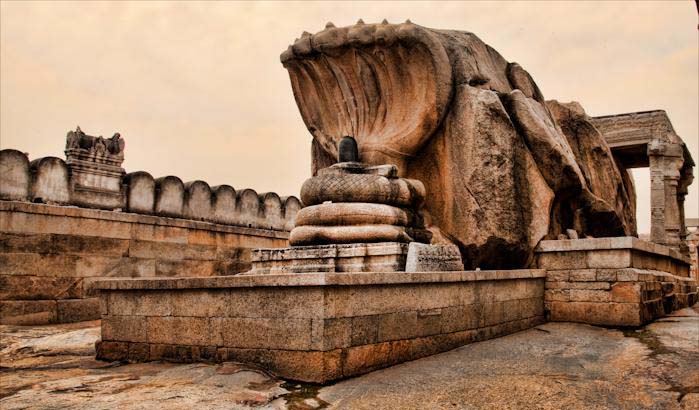|
|
Lepakshi Temple

Name of the Temple |
|
Location |
- Lépākṣhi village, 114 kms from Ananthapur city, Āndhrapradeśh.
|
| How to reach there? |
- By air : Thirupathi Airport is 240 km away. From there take the National Highway 71 heading west to reach Lépākṣhi. Bengalūru International Airport is around 100 km away. From the airport take the National Highway 7 north to reach Lépākṣhi.
- By train : The Hindhupur railway station in Hindhupur is the closest railway station, around 13 km away. From the railway station take the Lépākṣhi road heading east to reach Lépākṣhi.
- By road : Lépākṣhi is connected by the Bengalūru Haidherabādh Highway 7. The distance to Haidherabādh is 480 km and 120 km to Bengalūru.
|
Rulers/builders and Time Period |
- This Vīrabhhadra Temple at Lépākṣhi was built in the mid-16th century by Vīraṇṇa and Virupaṇṇa, Vijayanagara governors of Penukonḍa.
|
Deity |
- Lépākṣhi consists of three shrines dedicated to Śhiva, Viṣhṇu and 'Vīrabhhadhra',' and 'Dhurgā', of which the Vīrabhhadhra temple is the most important.
|
Architecture Style |
- The temple is divided into three parts - the 'Mukha Manṭapa', (also called 'Nithya Manṭapa' or 'Ranga Manṭapa'), the 'Arthha Manṭapa' and 'Garbhha Gruha', and the 'Kalyana Mandapa', with 38 carved monolithic pillars in grey sandstone is unfinished.
- These three form a triangle with a common Manṭapam. The Kalyāṇa Manṭapam is a standing monument to the exuberance of Vijayanagar art but it is left unfinished.
- The temple has a central pavilion, embracing all the three shrines. This pavilion is further connected with an intermediary hall and a hall for ritual dance. A large open court that is accessible from the east surrounds the main hall.
- Lépākṣhi Temple perhaps houses the largest monolithic structure of Nāgalinga in India.
- Another exquisite statue of Lord Ganeśha captures the attention of everyone, especially when people enter the second interior court.
- On the whole the temple is a brilliant example of the Vijayanagar style of architecture.
|
Special Features |
- There are many specialties in this temple like rock chain, Vāsthu Puruṣha image, Padhmini race Lady, Hanging Pillar , Dhurgā Pādham, Lépākṣhi saree designs etc.
- On the walls of this temple, there are several stories like Mahābhāratha, Rāmāyaṇa sculpted. Also on the roof, there are so many beautiful paintings done by natural colour mixtures.
- It contains some of the finest sculpture of the period and has the earliest preserved cycle of mural paintings in the Vijayanagara style.
|
Any Other/Remarks |
- One more famous spot in this temple is "Eyes of Virūpākṣhaṇṇa". As history says, due to king's misunderstanding with this temple builder, king ordered to blind him. Hearing this, the builder plucked his own eyes and threw them at the temple walls. Till date one can find those blood scars on that particular wall.
|
Special Reference to Performing Arts |
- The temple is surrounded on all sides by an outer enclosure.
- A second inner enclosure contains the main portion of the temple. Its finest parts are the 'Nātya' (Dancing) and 'Ardhha' (worship) Manṭapams.
- The former is decorated with superbly sculptured pillars on, which are carved life-size representations of musicians and dancers in various poses displaying spirit and vigor.
- The best specimens of the Vijayanagar style of sculpture and mural paintings are found in the Nātya and Kalyāṇa Manṭapams (dance and wedding halls). These sculptures depict Purāṇic episodes like those of 'Ananthaśhayana', 'Datthāthreya', 'Chathurmukha Brahma', 'Thumburu', 'Nāradha' and 'Rambhā'.
- The interiors boast of impressive sculptures in half-relief on the granite pillars. The carvings represent dancers, drummers and divine musicians. Here, you can see Lord Brahma playing drums, celestial nymph Rambhā dancing and Lord Śhiva engaged in 'Ānandha Thānḍava'.
- Lépākṣhi Temple has a colossal painting of Vīrabhadra in the central hall. In the 'Hall of Dance', one can trace eight panels, depicting Purāṇic legends on the ceiling. Most of the paintings and murals have been devastated by the ravages of times.
- Lépākṣhi is a notable store of expertise, which is on the brink of extinction. In concise terms, the temple is a work of art that certainly deserves a visit.
|
Bibliography |
|
|
View Larger Map 



|
|















